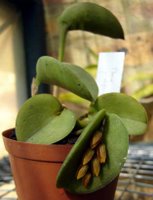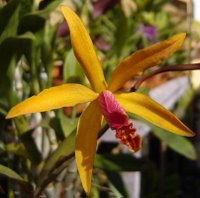 My throat feels scratchy and I'm all hot and bothered. I think I might be coming down with spring fever. Oh, dear...Watch this space.
My throat feels scratchy and I'm all hot and bothered. I think I might be coming down with spring fever. Oh, dear...Watch this space.
Biotechnology is my passion. After being inspired by Arcadia's Week Of The List, I would like to share 5 really cool things that 21st century biotechnology can do.
1. Ripe and ready to eat. CalGene's Flavr Savr tomato will always have a special place in history. It was the first ever GM food to be approved by the FDA way back in 1994. Normal tomatoes are picked green and hard and then left to ripen in the grocer's cooler. Flavr Savr tomatoes promised juicy vine-ripeness without spoiling during the picking, transportation and storage steps. This exceptional shelf-life worked by silencing the gene responsible for producing ethylene. This gas is produced by ripening fruit, especially bananas and avocados, and keeps the ripening process going. Without the ability to make ethylene, Flavr Savr tomatoes ripen on the vine to a pink blush and then stay in that state until they can be treated with exogenous ethylene right before putting them on display in the store. These GM beauties were last seen on shelves in 1997. Why were they pulled from the market? Not because of any fears about frankenfood, but because they were still picked and transported using traditional hard green tomato methods and equipment. Damage to the soft and squishy Flavr Savr tomatoes was as much as 30% by the time a desperate housewife could lay her hands on one. It was just not economically viable to keep the Flavr Savr going.2. Got silk? Spider silk has a myriad of potential uses. For a start, it's a really strong protein: stronger than kevlar or reinforced steel, we're told. It's of obvious interest to structural engineers and fashionistas who like their ball gowns bullet proof. But spider silk is a precious commodity and spiders do not cope well with being farmed. Nexia Biotechnology in Quebec Canada has produced transgenic goats that secrete spider silk in their milk. That's right. Just skim it off, stretch, leave to dry, spin into fibres. A visionary technique for mass-producing the fibre of the future.
3. Red alert. The Danish company Aresa has genetically modified the thale cress (Arabidopsis thaliana), a humble weed, to turn a bright red colour when it encounters unexploded land mines underground. This would help alleviate the suffering of people in countries riddled with dormant mines. The explosives slowly release nitrogen dioxide which then causes the leaves of the plant to turn their autumn colours. The genes responsible for producing the red pigment anthocyanin are usually switched off for most of the year, but these scientists have inserted an extra gene that turns on this whole biochemical pathway in the presence of nitrogen dioxide. In true Jurassic Park style, the company has made their patented BioSensor plants dependent on a specific fertilizer mix, so they won't escape into the wild.
4. Something fishy. Certain fish that live in Arctic and Antarctic waters secrete special proteins that protect them from freezing. If such a fish swallows a small ice crystal, these antifreeze glycoproteins bind to it and prevent it from growing larger. Scientists have already produced varieties of potatoes and tomatoes expressing these genes, with the potential to thrive where the dangers of frost would kill lesser crops. But would your salad still be vegetarian?
5. Hot stuff. This is an idea I had in my Honours year for a biotech experiment. Since tomatoes and chillies are in the same plant family, the Solanaceae, they share several characteristics. One feature exclusive to chillies is their burn. This is caused by the capsaicinoid molecules produced by the placenta (the membrane that connects the seeds to the fruit wall). Incidentally, capsaicinoids are produced by chillies to prevent mammals from eating the fruit. The mammalian digestive system destroys chilli seeds, whereas those of birds leave them intact to germinate. Birds do not have the pain receptors sensitive to capsaicinoids and therefore experience no heat rush when feasting on a habanero bush. How cool would it be to transform tomatoes with the genes for the enzymes in the capsaicinoid pathway? It should be a breeze, as the two crops are related. You then get hot tomatoes, useful in relishes and hot salsa. Land used for the production of tomatoes and chillies will be used for growing hot tomatoes with twice the yield. Simple? Not really. The enzymes that produce capsaicinoids haven't all been discovered yet. But if you give me some money, I'll gladly do it for you...
Strange how August is always colder than July. Tropical orchids are quite confused by the cold fronts of temperate climes - some are already well into their spring growing season, whereas others are still slumbering in winter dormancy. This month carries on with the warm colours of the flowers from the previous month. Here are five winter warmers to cheer you up.
 Dendrobium trigonopus. This truly delightful miniature species from South East Asia has bright yellow flowers and an apple green labellum with tiny red striations. It is also part of the Nigrohirsutae group in Dendrobium, which includes beauties like Den. formosum, Den. infundibulum and Den. cruentum. My plant grows mounted on a small piece of timber which is suspended from the roof of the greenhouse in a cool bright aspect. It has a delicious scent that some people say reminds them of honeysuckle. Personally, it reminds me of the smell of a candy shop. Pretty.
Dendrobium trigonopus. This truly delightful miniature species from South East Asia has bright yellow flowers and an apple green labellum with tiny red striations. It is also part of the Nigrohirsutae group in Dendrobium, which includes beauties like Den. formosum, Den. infundibulum and Den. cruentum. My plant grows mounted on a small piece of timber which is suspended from the roof of the greenhouse in a cool bright aspect. It has a delicious scent that some people say reminds them of honeysuckle. Personally, it reminds me of the smell of a candy shop. Pretty. Cymbidium Kusuda Shining. An exceptional modern compact variety. The inflorescence produces the blooms at large intervals for a Cymbidium, displaying them singly and making the whole appearance less cluttered. Bright yellow labellum with prominent dark chocolate markings makes a nice contrast to the rusty amber petals. The column is a darker, dusty rose colour with a light anther cap. Sunny.
Cymbidium Kusuda Shining. An exceptional modern compact variety. The inflorescence produces the blooms at large intervals for a Cymbidium, displaying them singly and making the whole appearance less cluttered. Bright yellow labellum with prominent dark chocolate markings makes a nice contrast to the rusty amber petals. The column is a darker, dusty rose colour with a light anther cap. Sunny.  Pleurothallis prolifera. This is a very strange orchid from Venezuela and Brazil. It has coriaceous (i.e. leathery) leaves, quite atypical for its genus and can be found growing lithophytically (that means on rocks, folks) in hot, dry places. Other Pleurothallis are usually found in moist cloud forests, so this one really is the odd one out. Microscopic striped flowers are carried on an inflorescence along the mid-vein of the leaf. Weird.
Pleurothallis prolifera. This is a very strange orchid from Venezuela and Brazil. It has coriaceous (i.e. leathery) leaves, quite atypical for its genus and can be found growing lithophytically (that means on rocks, folks) in hot, dry places. Other Pleurothallis are usually found in moist cloud forests, so this one really is the odd one out. Microscopic striped flowers are carried on an inflorescence along the mid-vein of the leaf. Weird.  Dendrobium Banana Royal. This plants is sometimes listed as Banana Royale. It has a lot of Den. canaliculatum influence and has to be grown in a warm situation with ample light. A dry winter rest is also required for successful flowering. Indeed, I've struggled for the last couple of years to get it to bloom. The flowers are small and twisted and are the colour of just-ripe bananas. Edible.
Dendrobium Banana Royal. This plants is sometimes listed as Banana Royale. It has a lot of Den. canaliculatum influence and has to be grown in a warm situation with ample light. A dry winter rest is also required for successful flowering. Indeed, I've struggled for the last couple of years to get it to bloom. The flowers are small and twisted and are the colour of just-ripe bananas. Edible.  Laeliocattleya Ronselensis. This is a primary hybrid between the dull green Cattleya forbesii and dimunitive orange Laelia cinnabarina. It was first registered in 1904 and again illustrates how the progeny of a cross can be a vast improvement over the parents. This plant carries golden yellow starry flowers with cherry red lips on a tall inflorescence. Perky.
Laeliocattleya Ronselensis. This is a primary hybrid between the dull green Cattleya forbesii and dimunitive orange Laelia cinnabarina. It was first registered in 1904 and again illustrates how the progeny of a cross can be a vast improvement over the parents. This plant carries golden yellow starry flowers with cherry red lips on a tall inflorescence. Perky.
 My throat feels scratchy and I'm all hot and bothered. I think I might be coming down with spring fever. Oh, dear...
My throat feels scratchy and I'm all hot and bothered. I think I might be coming down with spring fever. Oh, dear... Dendrobium trigonopus. This truly delightful miniature species from South East Asia has bright yellow flowers and an apple green labellum with tiny red striations. It is also part of the Nigrohirsutae group in Dendrobium, which includes beauties like Den. formosum, Den. infundibulum and Den. cruentum. My plant grows mounted on a small piece of timber which is suspended from the roof of the greenhouse in a cool bright aspect. It has a delicious scent that some people say reminds them of honeysuckle. Personally, it reminds me of the smell of a candy shop. Pretty.
Dendrobium trigonopus. This truly delightful miniature species from South East Asia has bright yellow flowers and an apple green labellum with tiny red striations. It is also part of the Nigrohirsutae group in Dendrobium, which includes beauties like Den. formosum, Den. infundibulum and Den. cruentum. My plant grows mounted on a small piece of timber which is suspended from the roof of the greenhouse in a cool bright aspect. It has a delicious scent that some people say reminds them of honeysuckle. Personally, it reminds me of the smell of a candy shop. Pretty. Cymbidium Kusuda Shining. An exceptional modern compact variety. The inflorescence produces the blooms at large intervals for a Cymbidium, displaying them singly and making the whole appearance less cluttered. Bright yellow labellum with prominent dark chocolate markings makes a nice contrast to the rusty amber petals. The column is a darker, dusty rose colour with a light anther cap. Sunny.
Cymbidium Kusuda Shining. An exceptional modern compact variety. The inflorescence produces the blooms at large intervals for a Cymbidium, displaying them singly and making the whole appearance less cluttered. Bright yellow labellum with prominent dark chocolate markings makes a nice contrast to the rusty amber petals. The column is a darker, dusty rose colour with a light anther cap. Sunny.  Pleurothallis prolifera. This is a very strange orchid from Venezuela and Brazil. It has coriaceous (i.e. leathery) leaves, quite atypical for its genus and can be found growing lithophytically (that means on rocks, folks) in hot, dry places. Other Pleurothallis are usually found in moist cloud forests, so this one really is the odd one out. Microscopic striped flowers are carried on an inflorescence along the mid-vein of the leaf. Weird.
Pleurothallis prolifera. This is a very strange orchid from Venezuela and Brazil. It has coriaceous (i.e. leathery) leaves, quite atypical for its genus and can be found growing lithophytically (that means on rocks, folks) in hot, dry places. Other Pleurothallis are usually found in moist cloud forests, so this one really is the odd one out. Microscopic striped flowers are carried on an inflorescence along the mid-vein of the leaf. Weird.  Dendrobium Banana Royal. This plants is sometimes listed as Banana Royale. It has a lot of Den. canaliculatum influence and has to be grown in a warm situation with ample light. A dry winter rest is also required for successful flowering. Indeed, I've struggled for the last couple of years to get it to bloom. The flowers are small and twisted and are the colour of just-ripe bananas. Edible.
Dendrobium Banana Royal. This plants is sometimes listed as Banana Royale. It has a lot of Den. canaliculatum influence and has to be grown in a warm situation with ample light. A dry winter rest is also required for successful flowering. Indeed, I've struggled for the last couple of years to get it to bloom. The flowers are small and twisted and are the colour of just-ripe bananas. Edible.  Laeliocattleya Ronselensis. This is a primary hybrid between the dull green Cattleya forbesii and dimunitive orange Laelia cinnabarina. It was first registered in 1904 and again illustrates how the progeny of a cross can be a vast improvement over the parents. This plant carries golden yellow starry flowers with cherry red lips on a tall inflorescence. Perky.
Laeliocattleya Ronselensis. This is a primary hybrid between the dull green Cattleya forbesii and dimunitive orange Laelia cinnabarina. It was first registered in 1904 and again illustrates how the progeny of a cross can be a vast improvement over the parents. This plant carries golden yellow starry flowers with cherry red lips on a tall inflorescence. Perky.